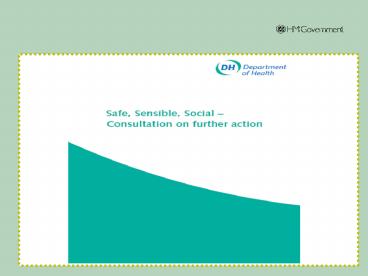The current situation - PowerPoint PPT Presentation
1 / 11
Title:
The current situation
Description:
Alcohol-related violent crime fell by a third, from about 1.5million incidents ... Over the past 5 years, the proportion of people who think drink and rowdy ... – PowerPoint PPT presentation
Number of Views:47
Avg rating:3.0/5.0
Title: The current situation
1
(No Transcript)
2
The current situation
- Alcohol-fuelled crime and disorder
- Alcohol-related violent crime fell by a third,
from about 1.5million incidents in 1997 to fewer
than 1 million in 2007/08 - Over the past 5 years, the proportion of people
who think drink and rowdy behaviour in public
places is a fairly big or very big problem in
their area rose from 22 to 25 of all those
asked. - Drinking by those young people under the age of
18 - The proportion of 11-15 year olds who have ever
drunk alcohol is falling (61 in 2003 to 54 in
2007). Average weekly consumption of alcohol by
11-15 year olds who do drink alcohol has varied
since 2000 with no clear pattern however,
average consumption in 2007 fell from 2006. Using
a revised method of calculation, those pupils who
drank in the last week consumed 12.7 units weekly
in 2007. - Drinking that causes ill health
- New statistics show alcohol-related hospital
admissions are rising by 80,000 admissions a
year, with 811,000 admissions (6 of all
admissions) in 2006.
3
Recent Developments
- Developing the evidence of harms
- Alcohol-related hospital admissions
- Independent review of the effects of alcohol
pricing and promotion - Reviewing self-regulatory commitments by the
alcohol industry - Monitoring the industrys voluntary labelling
agreement - KPMG review of social responsibility standards
document
4
KPMG were commissioned to undertake a review of
the alcohol industrys Social Responsibility
Standards
- KPMG carried out over 50 interviews and carried
out observations at 597 premises over 8 locations - Although there was some evidence of good
practise, overall they found - Standards not widely adhered to
- Not a catalyst for self-regulation
- Not an effective supplement to mandatory
requirements - No evidence to link them to a reduction in
alcohol-related harms
5
Governments initial view is that a revised code
should become mandatory
- A mandatory code might cover the following
issues - Alcohol social responsibility principles
- The sensible drinking message
- Marketing naming, packaging, pos, sponsorship,
websites etc - Retailing display, staff training
- Exit and dispersal
- Management and design of outlets
- Promotions
- Prevention of underage/intoxicated sales
6
The consultation asks the following questions on
responsible retailing practices
- What are the most important issues that need to
be addressed? - Should the same restrictions apply to
- All premises selling alcohol?
- All premises with some exemptions?
- Only certain types of premises?
- All premises within a defined area?
- A combination of the above?
7
The consultation considers 3 ways of making the
Standards more effective
- Revise the current code, keep it voluntary, but
encourage enforcers to consider it during
inspections - As option 1 but allow local authorities to agree
mandatory restrictions/requirements to all/some
premises in a problem area - Legislate to create either a stand-alone
mandatory code or introduce it as a condition of
licences.
8
Could price and promotions be dealt with in a
mandatory code?
- A voluntary code in which businesses agreed to
limit price/promotions is anti-competitive - Primary legislation is needed in order to limit
price/promotions though they could still be
included in a mandatory code - The Govt will consider the need to restrict
price/promotions following the consultation and
once the evidence (Phase II from ScHARR) is in.
9
Making sure advice and help are available for
those who need them
- Action to date
- DrinkCheck, Your Drinking You, improved
Drinkline - Direct marketing campaign
- Drinkaware - working with Industry
- Training HCPs and front-line workers
- Residential support
10
Questions
- Is there enough advice available? What else is
needed and who should provide? - Should alcohol advertising include health and
unit info? How could this be achieved? - In addition to treatment for the minority, what
else could be done, and by whom, to support those
who find it difficult to cut down?
11
Consultation Questions
- How might a new code be made effective in
stopping licensed premises from engaging in
practices that encourage people to drink
excessively and irresponsibly? - If there continues to be slow progress in
implementing a voluntary labelling scheme, should
the Government take the next steps to make it a
legal requirement to include health and unit
information on all bottles and cans? - What are the most important issues that need to
be addressed in an alcohol retailing code? - Should all the same restrictions be applied to
- all premises selling alcohol
- all premises with some exemptions
- only certain types of premises (if so, how would
you define one of these?) - all premises within an area experiencing
problems or - a combination of these.
- Should an alcohol retailing code be made
mandatory through further legislation? If so, how
should it be applied? - Should a mandatory code, if introduced, cover
proportionate and necessary actions to prevent
health harms as well as crime and disorder? - Do you think there is enough advice available for
those who want to drink less? What other kings of
help are needed and who should provide them. - Should alcohol advertising include health and
unit information? How could this be achieved? - In addition to providing alcohol treatment for
the small number of drinkers with a serious
dependency problem, what else could be done, and
by whom, to support people who find it difficult
to cut down on drinking.

